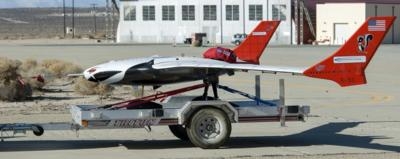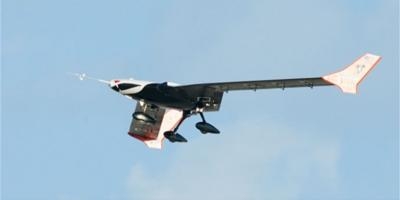Thu, Apr 17, 2014
Test Flights With A Flexible Wing To Be Conducted This Summer
The latest in a long series of experimental research aircraft, or X-planes, recently arrived at NASA's Armstrong Flight Research Center. Lockheed Martin, developer of the X-56A Multi-Utility Technology Testbed, is currently using the aircraft to explore technologies for active flutter suppression and gust load alleviation for the Air Force Research Laboratory's Multi-utility Aeroelastic Demonstration program.

The remotely piloted airplane had been housed at Edwards Air Force Base's North Base complex since last spring, where it was flown in a series of baseline tests involving a standard stiff wing. Pending resolution of scheduling and technical issues, the modular X-56A will be flown this summer with a flexible wing. Once these tests are concluded, the airplane and its ground control station will be transferred to NASA for follow-on research involving enabling technologies for new kinds of lightweight, energy-efficient, flexible aircraft.
According to NASA, the modular X-56A system includes two center bodies, a set of stiff wings, three sets of flexible wings, a ground control station, and a transportation trailer. The X-56A has easily removed wings and is convertible to other wing configurations, such as a joined-wing planform or a wing-tail configuration. The aircraft is equipped with a ballistic parachute recovery system, which is intended to recover the fuselage and the majority of the aircraft systems in the event of an inflight wing failure.

The initial flight tests of the X-56A system, performed by Lockheed and AFRL in the latter half of 2013 and extending into early 2014, collected flight data on highly flexible structures and flutter suppression control technology. Initially flown with a conventional stiff wing, the aircraft is subsequently being used to evaluate active flutter suppression with the flexible wings in early 2014. After these flights are completed, the X-56A will be transferred to NASA Armstrong to be used for research into lightweight structures and advanced control technologies for future efficient, environmentally friendly transport aircraft.
(Images provided by NASA)
More News
Light Gun A handheld directional light signaling device which emits a brilliant narrow beam of white, green, or red light as selected by the tower controller. The color and type of>[...]
"The journey to this achievement started nearly a decade ago when a freshly commissioned Gentry, driven by a fascination with new technologies and a desire to contribute significan>[...]
Aero Linx: JAARS, Inc. For decades now, we’ve landed planes on narrow rivers and towering mountains. We’ve outfitted boats and vehicles to reach villages that rarely se>[...]
"Our driven and innovative team of military and civilian Airmen delivers combat power daily, ensuring our nation is ready today and tomorrow." Source: General Duke Richardson, AFMC>[...]
Aircraft Conflict Predicted conflict, within EDST of two aircraft, or between aircraft and airspace. A Red alert is used for conflicts when the predicted minimum separation is 5 na>[...]
 ANN's Daily Aero-Term (04.20.24): Light Gun
ANN's Daily Aero-Term (04.20.24): Light Gun Aero-News: Quote of the Day (04.20.24)
Aero-News: Quote of the Day (04.20.24) ANN's Daily Aero-Linx (04.21.24)
ANN's Daily Aero-Linx (04.21.24) Aero-News: Quote of the Day (04.21.24)
Aero-News: Quote of the Day (04.21.24) ANN's Daily Aero-Term (04.21.24): Aircraft Conflict
ANN's Daily Aero-Term (04.21.24): Aircraft Conflict




